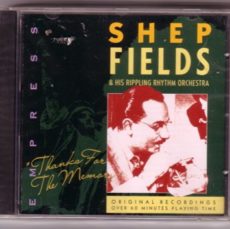
Daily Dose Of Jazz…
Shep Fields was born Saul Feldman in Brooklyn, New York on September 12, 1910, He played the clarinet and tenor saxophone in bands during college. In 1931 he played at the Roseland Ballroom and by 1933 he led a band that played at Grossinger’s Catskill Resort Hotel. In 1934 he replaced the Jack Denny Orchestra at the Hotel Pierre in New York City. He left the Hotel Pierre to join a roadshow with the dancers,Veloz and Yolanda. In 1936 his performance at Chicago’s Palmer House was broadcast on the radio.
The sound of his wife was blowing bubbles into her soda became his trademark that opened each of his shows. Holding a contest in Chicago for fans to suggest a new name for the band and with “rippling” suggested in more than one entry, Fields came up with “Rippling Rhythm.”
By 1936 he received a recording contract with Bluebird Records and had hits Cathedral in the Pines, Did I Remember? and Thanks for the Memory. In 1937 Fields replaced Paul Whiteman in his time slot with a radio show called The Rippling Rhythm Revue with Bob Hope as the announcer. In 1938, Fields and Hope were featured in his first feature-length motion picture, The Big Broadcast of 1938.
In 1941 Fields revamped the band into an all-reeds group, with no brass section. “Shep Fields and His New Music,” featuring band vocalist Ken Curtis. He reverted to Rippling Rhythm in 1947.
He disbanded the group in 1963, moved to Houston, Texas and became a disc jockey, later worked at Creative Management Associates with his brother Freddie. Shep Fields, who made a mark during the Big Band era, passed away on February 23, 1981 at Cedars-Sinai Medical Center in Los Angeles, California from a heart attack.
![]()


